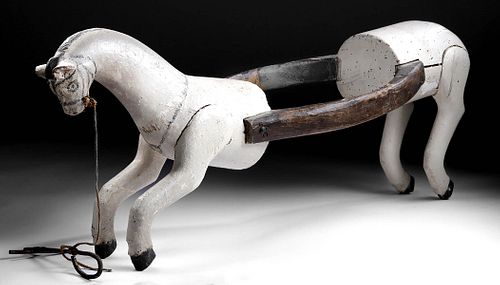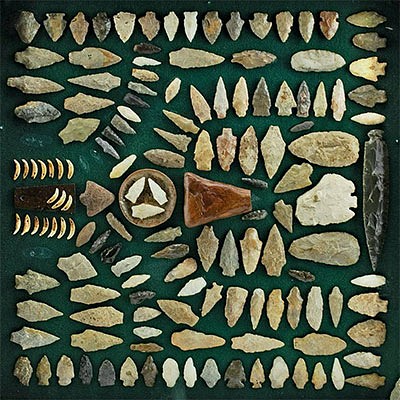20th C. Mexican Painted Wood Horse - Caballo Santiago
Lot 124c
About Seller
Artemis Gallery
686 S Taylor Ave, Ste 106
Louisville, CO 80027
United States
Selling antiquities, ancient and ethnographic art online since 1993, Artemis Gallery specializes in Classical Antiquities (Egyptian, Greek, Roman, Near Eastern), Asian, Pre-Columbian, African / Tribal / Oceanographic art. Our extensive inventory includes pottery, stone, metal, wood, glass and textil...Read more
Estimate:
$700 - $1,050
Absentee vs Live bid
Two ways to bid:
- Leave a max absentee bid and the platform will bid on your behalf up to your maximum bid during the live auction.
- Bid live during the auction and your bids will be submitted real-time to the auctioneer.
Bid Increments
| Price | Bid Increment |
|---|---|
| $0 | $25 |
| $300 | $50 |
| $1,000 | $100 |
| $2,000 | $250 |
| $5,000 | $500 |
| $10,000 | $1,000 |
| $20,000 | $2,500 |
| $50,000 | $5,000 |
| $100,000 | $10,000 |
| $200,000 | $20,000 |
About Auction
By Artemis Gallery
Apr 28, 2022
Set Reminder
2022-04-28 12:00:00
2022-04-28 12:00:00
America/New_York
Bidsquare
Bidsquare : Art & Artifacts of North America
https://www.bidsquare.com/auctions/artemis-gallery/art-artifacts-of-north-america-9276
Join us for a special auction not to be missed! Collectible Native American art from two major collectors. Antiquity to mid-20th century! Plus fine & folk art, fossils, and more! All legally acquired. All legal to buy/sell. Convenient and professional in-house shipping. Artemis Gallery info@artemisgallery.com
Join us for a special auction not to be missed! Collectible Native American art from two major collectors. Antiquity to mid-20th century! Plus fine & folk art, fossils, and more! All legally acquired. All legal to buy/sell. Convenient and professional in-house shipping. Artemis Gallery info@artemisgallery.com
- Lot Description
North America, Mexico, Puebla, ca. early to mid 20th century CE. A hand-carved wooden horse known as a "Caballo Santiago" from the traditional Santiago Dance. It features a round opening ringed by curved wooden bars so that it can be worn around the waist by a dancer known as a Santiaguero, a follower of Saint James (Santiago). The horse is carved as if in motion and wears a bridle. Size: 12" L x 40" W x 15.2" H (30.5 cm x 101.6 cm x 38.6 cm)
The Santiago dance portrays an encounter between Santiago Caballero, a reincarnation of Saint James the Apostle who appears as an archangel mounted atop a white stallion, and a group of dancers representing Satan and his followers, known as the Pilatos (after Pontius Pilate). The dance also features the subtext that the Santiagueros, who are mostly the Indians of the Sierra de Puebla, represent the true followers of Christ while the Pilatos represent the Spanish conquistadors who claimed to be Christians but treated the Indians poorly. The horse itself is treated with great respect, with one dancer whose sole role is to protect it.
Provenance: private Tucson, Arizona, USA collection, acquired between 1950 and 1985
All items legal to buy/sell under U.S. Statute covering cultural patrimony Code 2600, CHAPTER 14, and are guaranteed to be as described or your money back.
A Certificate of Authenticity will accompany all winning bids.
PLEASE NOTE: Due to recent increases of shipments being seized by Australian & German customs (even for items with pre-UNESCO provenance), we will no longer ship most antiquities and ancient Chinese art to Australia & Germany. For categories of items that are acceptable to ship to Australia or Germany, please contact us directly or work with your local customs brokerage firm.
Display stands not described as included/custom in the item description are for photography purposes only and will not be included with the item upon shipping.
#147564Wear on surface commensurate with age, including some weathering to the pigment and small surface cracks, as well as a few chips, nicks, and scratches. The hair from the horse's tail is mostly lost.Condition
- Shipping Info
-
All shipping is handled in-house for your convenience. Your invoice from Artemis Gallery will include shipping calculation instructions. If in doubt, please inquire BEFORE bidding for estimated shipping costs for individual items.
-
- Buyer's Premium



 EUR
EUR CAD
CAD AUD
AUD GBP
GBP MXN
MXN HKD
HKD CNY
CNY MYR
MYR SEK
SEK SGD
SGD CHF
CHF THB
THB















